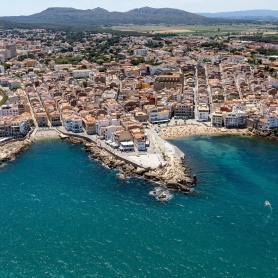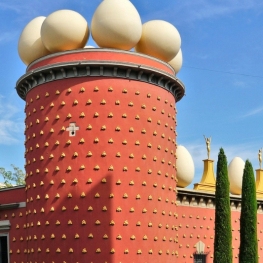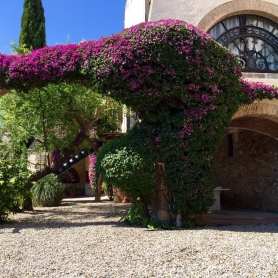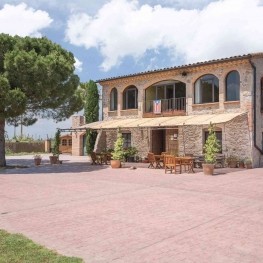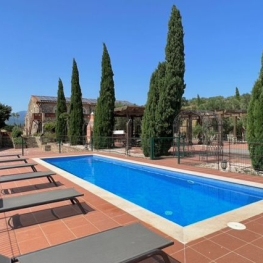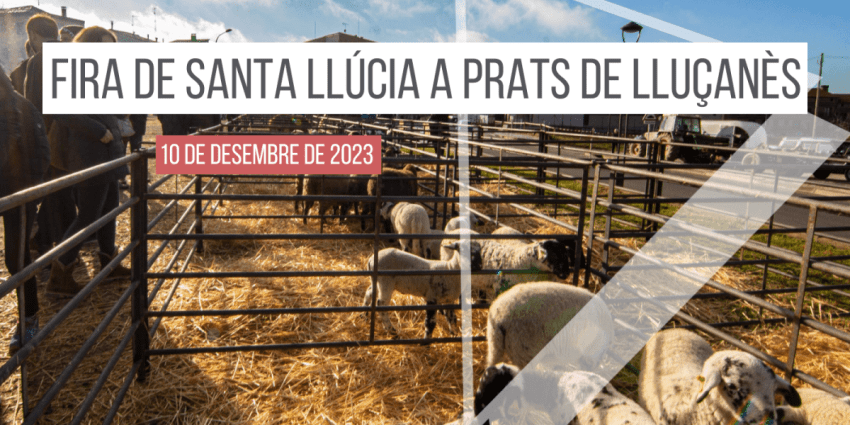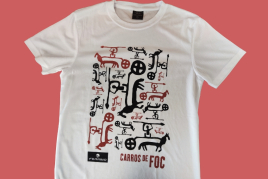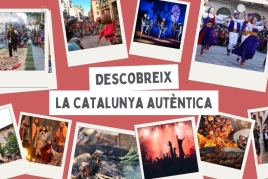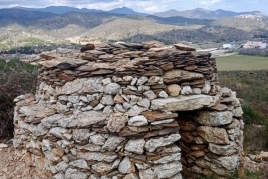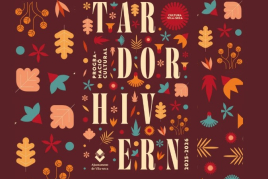Monumental route through the historic center of Castelló d'Empúries
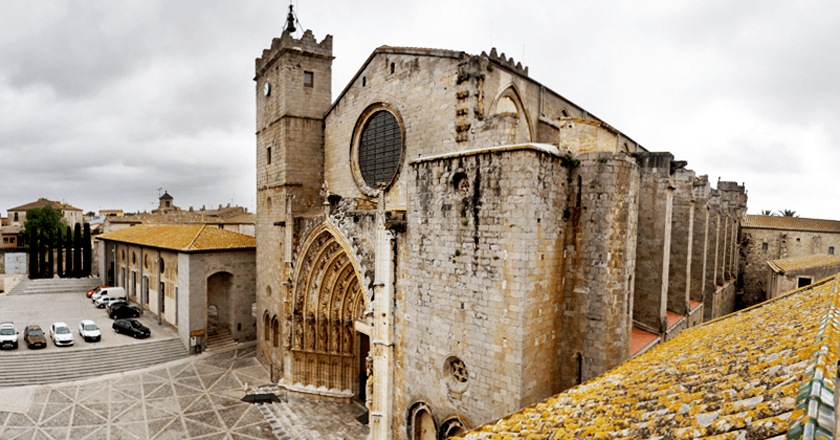
For different reasons the Counts of Empúries moved the capital of the County, and their residence, from the Greek and Roman San Martin de Ampurias to the "Villa Castilione" and new Villa Condal: Castelló d'Empúries.
It is said that in the eleventh century, the counts of Empúries already installed their residence and became, thus, the new capital of the County. Of this century also dates, the official consecration of the church of Santa Maria: it was the 9 of September of the year 1064, when still the structure of the temple was of Romanesque style. Over time, and at the end of the thirteenth century, the Gothic takes center stage and the three naves stand on lateral columns. The facade, with its magnificent cover, dates from the early s. XV, and the altarpiece of the Virgen de la Candelaria, from the end of the same century.
The bell tower (Romanesque and transitional), the baptismal font (11th century), the Portal de la Gallarda and the base of the Walls or even the Old Bridge, which could be classified, are also preserved almost intact from the early medieval times. of the late thirteenth century. There are numerous other buildings that can also be seen, and that although begun in medieval times, are finished in the seventeenth and eighteenth centuries. We found, as well, many convents and civil buildings.
The historic monumental center still retains much of its layout and traditional appearance, with arcaded squares and the names of the streets that make clear reference to the activity that was taking place: Calle del Burdel, Plaza de las Coles, Wine, Oil, Chickens, etc. Among the neighborhoods is the Jewish Call, the Temple, in honor of the knights of the Order, the Executioner, San Lazaro, etc.
Next, we will explain the points of interest of the route that you will also find in each building.
1. Public laundry
 The public laundry is an attractive construction of the 19th century that incorporates elements of the former convent of San Francisco, erected in 1264 near this place. The Tuscan columns stand out (sixteenth or seventeenth centuries) that should have been part of the cloister. They are integrated into the arcaded galleries that surround the laundry room, which has a fountain in the center.
The public laundry is an attractive construction of the 19th century that incorporates elements of the former convent of San Francisco, erected in 1264 near this place. The Tuscan columns stand out (sixteenth or seventeenth centuries) that should have been part of the cloister. They are integrated into the arcaded galleries that surround the laundry room, which has a fountain in the center.
2. Rec del Molí and Ecomuseo - Farinera
La Farinera de Castelló was created in the place of Molino del Medio, one of the three medieval mills of the city, taking advantage of the old "Acequia del Molí". It is a large three-storey industrial building built around 1905 on the previous one, where you can see the old machinery, mostly wood, partially renovated in the mid-twentieth century.
Today the Ecomuseum-Farinera, attached to the Museum of Science and Technology of Catalonia, allows to know the transformation of wheat into flour, which here adopted the Austro-Hungarian system.
3. Ancient synagogue
In this building of the street of the Jews, in the mount of the Bad Era, in the primitive nucleus of the medieval call, was the first synagogue or school of the Jewish community of Castelló. The 1442 recovered its function, that maintained until the expulsion of the Jews of 1492.
4. Jewish Quarter
The important Jewish community of Castelló d'Empúries is documented since the mid-thirteenth century. He enjoyed privileges granted by the counts and came to have about 300 inhabitants. It was extinguished, practically, with the decree of expulsion of the Catholic Kings of 1492.
The old call included the area of the streets of the Wall, the Jews, the Call, the Calabró, Pescaderías Viejas, Plaça de la Lana; it maintains the irregular urban plot of medieval times.
5. New synagogue
In the building known as Casa Hornos, then Can Comas, on Calle de las Pescaderías Viejas, on the Mercadal hill, the new school or synagogue of the Castellón Jewish community was founded. It is documented since the end of the thirteenth century. The portal to the left of the facade was the access to the prayer site.
6. Curia and prison
 Gothic building built around 1336 that integrated two functions of the medieval town: the Curia, seat of the court of justice, and the prison where the convicts entered. In the Curia, at noon, the façade overlooking Plaza de Jaume I (former Plaza del Grano) stands out, with Gothic windows that have been restored; in the interior noteworthy corbels of carving.
Gothic building built around 1336 that integrated two functions of the medieval town: the Curia, seat of the court of justice, and the prison where the convicts entered. In the Curia, at noon, the façade overlooking Plaza de Jaume I (former Plaza del Grano) stands out, with Gothic windows that have been restored; in the interior noteworthy corbels of carving.
The Prison, to the north, has a voussoir doorway and two barred windows in the façade. Inside, small cells are distributed around the patio. Curious graffiti made by prisoners at different times have been preserved.
7. Convent of Sant Agustí
The Augustinian friars were installed outside the walls of Castelló in the thirteenth century and moved into the town due to the wars of the seventeenth century.
The church (on basements) is engraved in 1749 on the cover and has an outstanding bell tower. It is privately owned since the confiscation of the nineteenth century, along with the convent building (Torrecabota house). On the facade of the church you can see a fragment of a Jewish tombstone.
8. Convent of Sant Jaume and Condal palace
The Dominicans founded their convent in 1317 near the wall (the "Strength of the Preachers"). In the second half of the 14th century, the Count's palace was built, which Count Pedro II ceded to the friars in 1401. The reconstruction of the convent in the XVII-XVIII centuries incorporated a tower of the wall and other parts of the medieval building, such as "Gothic room".
The façade of the church is of classicist baroque style, dated in 1701. Next to it is the cloister, as a porticoed courtyard, where some antique, decorative and epigraphic pieces are exhibited. Today, the dependencies around it host the Casa de la Villa and different municipal services.
9. Council House: Lonja de Mar
The House of the Municipal Council of Castellón or Lonja del Mar medieval, later continued as the seat of the City Council. It retains the structure of the late fourteenth century (of verse 1393), with reforms of the eighteenth century. Note the façade with the large shield in relief, the interior space with Gothic ribbed vault that has the emblem of the city to the key and the side openings with columns and capitals.
10. The Convent of Santa Clara
The convent of Clarisse nuns of Castelló was founded outside the city walls in 1260. It was moved within the city core at the end of the 17th century due to the disastrous effects of the wars. The large built complex, built around 1683, consists of the church of a single nave, next to noon, and an austere cloister with galleries of semicircular arches, around which the monastic dependencies were organized.
11. St. Mary's Basilica
 The Gothic parish church of Santa María has a structure and dimensions of a cathedral, a dignity that did not succeed despite the various attempts, in this sense, the Counts of Empúries. It is one of the most interesting examples of Gothic religious architecture in Catalonia.
The Gothic parish church of Santa María has a structure and dimensions of a cathedral, a dignity that did not succeed despite the various attempts, in this sense, the Counts of Empúries. It is one of the most interesting examples of Gothic religious architecture in Catalonia.
12. Term cross
Gothic cruiser of the XV century, remarkably sculpted. Originally it was on the outskirts of the town and for a long time it was in the cemetery, from where it was moved in 1963 in the place it now occupies. On one side of the cross we can see the Crucifixion, with the Virgin and Saint John at the ends, the pelican, allusive
to the compassion and love of Christ, above, and the resurrection of Adam, which symbolizes redemption, at the feet.
On the reverse, we see the Virgin with the Son, accompanied by the Tetramorph: the symbols of the evangelists. To the octagonal knot or capital, small images of
eight apostles under canopies.
13. Contracting room
Set of gothic arcades, partly reconstructed, often called "La Lonja". It can belong to the medieval customs of Castellón, or in the rooms of the Hospital Mayor or the poor of the city that was founded in 1252 in this place.
14. Cemetery of the Jews Conversos
15. Walls of Castelló (Portal de la Gallarda)
 The Portal de la Gallarda, at the base of a rectangular tower or Gothic tower-portal, was the entrance to the fortified town of Castelló on the east side. It is located on the channel of El Molino, which takes advantage of the old moat in the sector of wall still more conserved of the city, forming part of the route altomedieval, which was renovated in the XIII-XIV centuries. To extramuros this section of fortification can be contemplated, next to the apse of the cathedral.
The Portal de la Gallarda, at the base of a rectangular tower or Gothic tower-portal, was the entrance to the fortified town of Castelló on the east side. It is located on the channel of El Molino, which takes advantage of the old moat in the sector of wall still more conserved of the city, forming part of the route altomedieval, which was renovated in the XIII-XIV centuries. To extramuros this section of fortification can be contemplated, next to the apse of the cathedral.
16. Big House
Residential building of the Castellón nobility of the Late Middle Ages, outstanding piece of the historical heritage of the town. Its facade, austere force, with the lintel doorway and the two slender mullions, defines this casal as a very remarkable example of Catalan civil Gothic (14th or 15th centuries).
17. Fossar of the Jews
18. Convent of Sant Bartomeu or de la Mercè
The convent of Sant Bartomeu of Mercedarian friars founded San Pedro Nolasco in 1238 on the outskirts of the town, near the "Puente de la Mercè" of the Acequia del Molino, in the time of Count Ponç Hug III.
In the eighteenth century was moved to the intramural, next to the portal of the Virgin Mary where he subsisted until the confiscation of the nineteenth century. In the courtyard of the Nouvilas house there are two galleries of the cloister of Renaissance influence, with reduced arches and Tuscan columns. It is an important and little known monument of the cultural heritage of Castelló.
19. Asylum Toribio Durán
Asilo Duran was inaugurated in 1898 thanks to the legacy of the Castellón philanthropist Toribi Duran Garrigolas (1814-1888), an industrialist who made his fortune in America and who also founded the Asilo Duran in Barcelona.
The large eclectic building, which incorporates a chapel, is characteristic of its time; the project has been attributed to the Barcelona architect Enric Sagnier i Villavecchia. Today, duly restored and updated, it continues in its assistance function.
20. Old Bridge
 The "Old Bridge", on the Muga, edge of the old neighborhood of Sant Marc, was originally called Puente Mayor or Puente Nuevo, since there was another older, missing. This medieval bridge of seven unequal eyes, it seems that it was built in the XIV century in the times of Count Pedro I. It has been repaired in different times for having suffered damages caused by wars and downpours.
The "Old Bridge", on the Muga, edge of the old neighborhood of Sant Marc, was originally called Puente Mayor or Puente Nuevo, since there was another older, missing. This medieval bridge of seven unequal eyes, it seems that it was built in the XIV century in the times of Count Pedro I. It has been repaired in different times for having suffered damages caused by wars and downpours.
21. Carlina Tower
The tower or strong rifle was built at the entrance of Castelló by the side of the river, in the second half of the nineteenth century, by the "Regiment of Toledo", intended to renew the defense fortifications of the city against the Carlists. It is a cylindrical and ataludada tower, with loopholes and battlements.
Source: Tourism Castelló
What to do
Canònica de Santa Maria de Vilabertran
Vilabertran (a 8.3 Km)Santa Maria de Vilabertran is, without a doubt, one of the best…
Teatre-Museu Dalí
Figueres (a 9.5 Km)Get to know the artist hidden behind the facade of his mustache…
Where to sleep
Can Gibert Apartaments Turístics
Castelló d'EmpúriesLocated in the historic centre of Castelló d'Empúries, Can Gibert offers 6…
Mas del Joncar
Sant Pere Pescador (a 7.5 Km)The farmhouse is located in Sant Pere Pescador surrounded by fruit fields,…
Mas Renart
Mollet de Peralada (a 13.4 Km)Enjoy and relax at the Mas Renart Rural House. For groups and…


